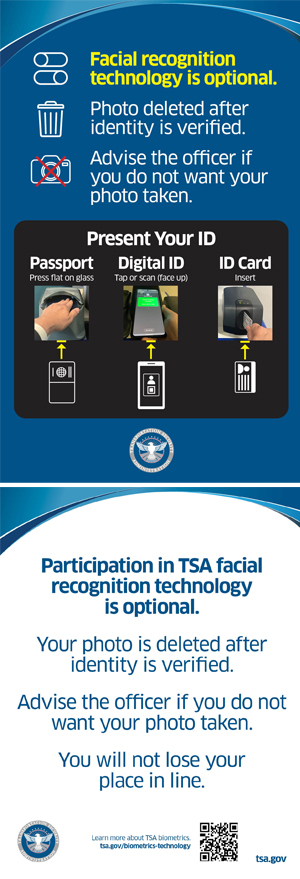
Identity verification is foundational to the Transportation Security Administration’s (TSA) risk-based approach to transportation security by verifying each traveler receives the appropriate level of risk-based screening. TSA strives to enhance security effectiveness and improve operational efficiency, while creating an enhanced traveler experience and strengthening privacy.
TSA introduced facial recognition technology into the screening process at select airports. The facial recognition technology represents a significant security enhancement and improves traveler convenience. A traveler may voluntarily agree to use their face to verify their identity during the screening process by presenting their physical identification or passport. The facial recognition technology TSA uses helps ensure the person standing at the checkpoint is the same person pictured on the identification document (ID) credential. Photos are not stored or saved after a positive ID match has been made, except in a limited testing environment for evaluation of the effectiveness of the technology.
The agency is using second-generation Credential Authentication Technology (CAT-2) scanners as travelers enter the screening process. This technology assists Transportation Security Officers (TSOs) in verifying the authenticity of a traveler’s ID credential, as well as their flight status and vetting status. TSOs must direct all travelers to the proper lane, either TSA PreCheck® screening, standard screening, or enhanced screening. The CAT-2 units are currently deployed at nearly 84 airports nationwide, and will expand to the more than 400 federalized airports over the coming years.

Photo: Courtesy TSA.
TSA is also using CAT-2 units to conduct an operational assessment of digital IDs, including mobile driver’s licenses. All digital IDs eligible for use at select TSA checkpoints follow the current, international open standards developed by the International Organization for Standardization and provide enhanced security and privacy by design.
TSA policy requires that TSOs show each traveler respect and ensure their privacy is protected. Travelers who do not wish to participate in the facial recognition technology process may decline the optional photo, without recourse, in favor of an alternative identity verification process, which does not use facial recognition technology to verify their identity. This action will not take longer and travelers will not lose their place in line for security screening. TSA is committed to protecting traveler privacy, civil rights, civil liberties and ensuring the public’s trust as it seeks to improve the traveler experience through its exploration of identity verification technologies.
TSA is currently updating CAT-2 screens with clear language that notifies travelers they may decline having their photo taken. TSA also has signage posted at the checkpoint indicating that the technology is optional and travelers may decline having their photo taken. Travelers under 18 are not photographed.
TSA is grounding its exploration of facial recognition solutions in rigorous scientific study and analysis to include alignment with National Institute of Standards and Technology (NIST) standards and applies stringent safeguards for traveler privacy and convenience:
- Standard ID credential verification is in place – Travelers who decide not to participate in the use of facial recognition technology will receive an alternative ID credential check by the TSO at the podium. The traveler will not experience any negative consequences for choosing not to participate. There is no issue and no delay with a traveler exercising their rights to not participate in the automated biometrics matching technology.
- Biometrics are not used for surveillance – Facial recognition technology is solely used to automate the current manual ID credential checking process and will not be used for surveillance or any law enforcement purpose. TSA uses facial recognition CAT-2 technology only to verify the identity of the traveler at the podium and make a determination for access into physical security screening.
- Accuracy is key to security effectiveness – TSA is committed to using the highest performing matching algorithms and designing solutions to mitigate the impact of environmental and technical variability such as lighting, background and focal length. TSA uses facial recognition algorithms developed by top-performing vendors, as noted in NIST’s ongoing evaluation. TSA is further committed to ensuring continued accuracy of these systems across all demographic groups.
Traveler safety is paramount. Fraudulent IDs and imposters represent an emerging threat to security. Following the 9/11 attacks on our nation, Congress established TSA as an agile and innovative security agency and gave it the task of protecting the free movement of people and goods through the nation’s transportation system. TSA’s employees are mission-focused and committed to closing security gaps and mitigating emerging threats.
For more information on TSA’s use of facial recognition technology and other emerging checkpoint technologies, please go to https://www.tsa.gov/news/press/factsheets/technology.
